POLYPHONIC TEXTURE AND GENRES
Polyphony
Polyphony (polyphonic texture) is an important texture in all historic
style periods. Polyphony contains two or more active melodies. In
contrast to homophony, emphasis is placed upon the interplay between
lines rather than on a single melody or a stream of chord sounds. The
interplay of contour, motives, continuity features, and rhythms are
important factors in polyphonic texture.
Rhythmic Strata
Rhythmic stratification, also called layers, results when two or more
voices move at different but closely related levels of rhythmic
activity. One voice may contain mostly quarter notes while another
contains eighth notes. This is somewhat like different parts of a
machine moving at different but related speeds. Layering is an
important feature of polyphonic texture.
Roles of Voices;
In polyphony, all the voices may be equally important—or one voice
may be more prominent than the others. Voices may join in couplings or
conversation-like exchanges, a polyphonic feature present in most of
Bach's chorales.
Individual voices change roles in polyphony more frequently than in
homophonic texture. These roles change periodically and systematically
in canons, inventions, or fugues. The voices may share the same motive
ideas and be closely related by content. Conversely, some or all of the
voices may use motives that differ from those used in other voices.
This causes greater independence among the voices.
The high voice is the principal melody in the next passage, the low
voice a subordinate accompanying melody. The excerpt is polyphonic
because a melody is accompanied by another. A quarter note rhythmic
strata (layer) is established in the bass that provides a steady
rhythmic background to the melody. The rhythms in the top line are more
varied.
Example 1: March in D Major J. S. Bach

Counterpoint
Counterpoint is the interaction of voices in polyphonic texture.
Imitative counterpoint occurs if one voice repeats or mimics the
patterns just stated in another voice. A canonic process occurs if the
anwering voice or voices repeat the lead voice exactly. A composition
based upon this process is a canon. Imitation is continuous throughout
a canon. The next excerpt is the beginning of the fourth movement of a
sonata. The violin is in canon with the top voice of the piano.
Example 2: Canon in Sonata for Violin and Piano César Franck
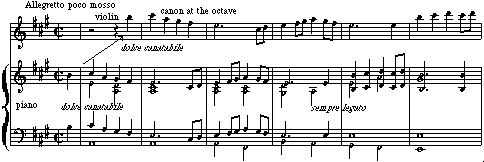
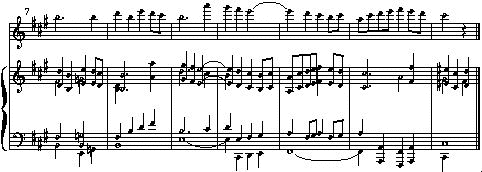
Imitation Intervals and Time Intervals
One voice may imitate another at the same or different pitch level. The
interval of imitation is the interval of transposition. If the the
answering voice does not change level, imitation is "at the
unison." The previous example was in canon at the octave.
The time interval measures the number of beats between the beginning of
the original idea and the answer. Time intervals vary in length and
sometimes change within a composition.
Both voices are of equal importance in the next example. One voice
imitates the other in a canon-like pattern but imitation ceases two
measure before the cadence. The first two measures are imitated in
inversion. The lead voice is repeated at the perfect fifth, thus the
interval of imitation is P5. The imitation occurs two beats later
thus the time interval (delay) is two beats.
Example 3: Cantione no. 1 Orlando de Lassus


Discounting the middle voice, the next excerpt has the following
features: a. the two essential voices (top and bottom) are of equal
importance b. the two voices are independent in rhythm, contour, and
content. c. the voices do not exchange roles. The middle voice
strictly parallels the top voice at the interval of a P4, an example
of organum. Perform the example with and without the middle voice
and note the difference in effect.
Example 4: from Missa Sancti Jacobi Dufay
Communio

The next example has the following features: a. All voices are of
equal importance b. All voices are independent in contour, rhythm, but
NOT in content. Each voice repeats ideas presented in
the lead voice c. The roles of the voices change as each new voice
enters in imitation of the preceding voice. Each
voice continues in free counterpoint after repeating three measures
of the lead voice. Compare mm. 4-6 of the middle voice with mm. 6-8
of the bottom voice. The pattern is imitative but not canonic.
Example 5: from Missa Aeterna Christi Palestrina
Benedictus
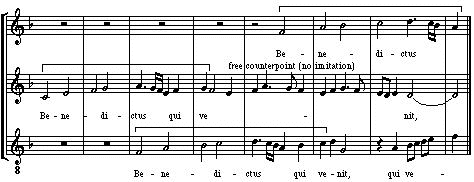
Non-imitative Polyphony
The next excerpt illustrates two-part, non-imitative polyphony because
the ideas in one voice do not recur in the other. The texture is
polyrhythmic instead of monorhythmic because the voices never use the
same rhythm patterns at the same time. The contours move in opposition.
The net result is two independent lines.
Example 6: Virelai Machaut


In the next excerpt, the two treble parts form one coupled voice while
the bass provides a sixteenth note contrast. This produces two distinct
rhythm layers. The contrast between the treble and bass voices is
caused by differences in rhythm and contour.
Example 7: from Sonata da camera a tre,op. 4 Corelli
Allemanda, allegro

The next excerpt is four-part polyphony. Three of the four voices use
similar motive material to establish a unity among these voices.
Although these voices are related by motive content, the texture is
non-imitative. The chorale tune (Jesu, meine Freude) is in the soprano
voice. Contrast is supported by rhythmic strata, quarter notes in the
tune in opposition to eighths and sixteenths in the other voices. The
result is the polyphonic accompaniment of a melody.
Example 8: from the Little Organ Book Bach
Chorale Prelude; Jesu, meine Freude, BWV 610
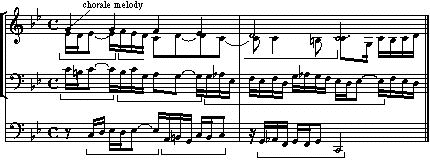
Imitative Polyphony
The next excerpt is two-part, imitative polyphony. One voice mimics the
motive ideas of the other. The texture is polyrhythmic because two
distinct rhythmic strata are present, one in eighth notes and the other
in sixteenths. The roles of the voices alternate in a cyclical pattern.
Bach called this kind of composition an invention, a fugue-like process
that features the systematic recurrence of a thematic idea called a
subject. The sixteenth note motive is the main thematic idea of this
invention.
The eighth note motive is an accompaniment figure. All the material in
the invention is derived from these two ideas.
The subject is stated in each voice. This is followed by a passage
made up of figures derived from the first two measure. This
procedure is repeated two more times in the composition (not shown
here).
A complete invention is included in the applications at the end of this
chapter. When analyzing this invention, note how the beginning of each
section is defined by the recurrance of the subject.
Example 9: Invention No. 4 Bach



The next excerpt is three-part imitative polyphony. A three-measure
melodic idea is repeated verbatim in the other voices. Once the idea is
stated, each voice continues with an accompaniment pattern of
nonimitative counterpoint. The process is canon-like but not a strict canon.
Example 10: Sanctus from Missa Aeterna Christi Palestrina
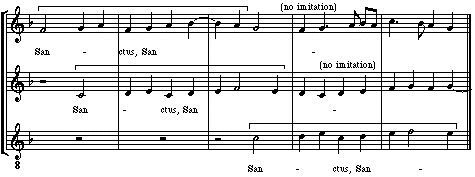
The Desprez excerpt is made up of two two-part canons, a double canon.
The soprano and alto make up one canon and the tenor and bass the other.
The voices in each canon are identified with Roman numerals.
Example 11: Baises moy Desprez
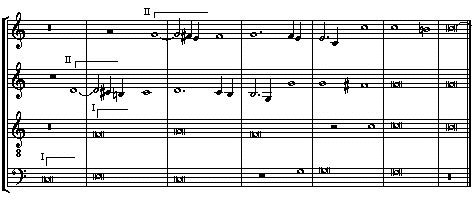
Harmony in Polyphony;
Polyphonic texture can be reduced to a basic harmonic core, usually a
monorhythmic chorale-like pattern . This is done by removing rhythmic
ornamentation and noting underlying voice leading. As shown in the next
excerpt, even two-part polyphony implies a harmonic core.
Example 12: March in D major J. S. Bach
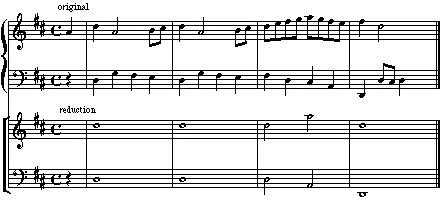
As more voices are added, the impression of background chords becomes
more complete This can be seen in the next two examples.
Example 13. I Gave Her Cakes Purcell
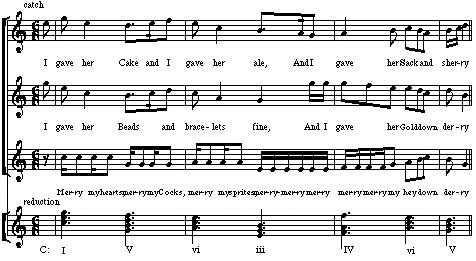
In the next example, the rhythm of the background harmony is less
supportive of the meter. Use of more third relations in this
progression softens the focus on tonic.
Example 14. Agnus Dei Palestrina
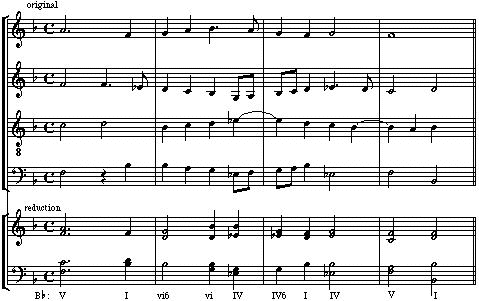
Texture Analysis;
Texture Variables;
Prominent rhythmic and melodic ideas are heard as figure on ground. The
performing medium and texture are elements of this ground, helping to
establish an environment that influences the meaning of figure. Changes
in this ground often support basic changes in the pattern and structure
of a composition—the form of the composition. The textural map of
a composition is an aspect of its form.
Variations in texture pattern contribute greatly to the form and mood of
a composition. Composers and arrangers coordinate changes in texture
with changes of key, mode, melodic pattern, continuity, rhythm, and
harmonic background.
Texture factors contribute to the development of musical form. These
factors are used as both constants and variables. When used as
constants, textural patterns establish steady states that give a section
of a composition its characteristic features.
When used as variables, changes in texture pattern create contrasts that
stimulate the listener's attention. These contrast help to establish
new sections in the form of the composition.
Case Study 1, Oculus no vidit (Orlandus Lassus)
The short composition in the next example illustrates how a composer
controls texture to shape a composition and sustain interest. Perform
and listen to this composition while analyzing it. Refer to Appendix F
for information on factors that affect textural pattern. Make a copy of
the appendix to avoid page flipping.
Overview
The composition is through-composed and each section starts with a new
motive. Each section of this composition is marked by a letter in a
box. The phrases within each section are marked by lower case letters.
The interval of imitation is enclosed in parentheses. These intervals
change during the course of the work. The ascending and descending P4
motive recur as parts of new thematic ideas (compare sections B and D).
The Latin text of this composition translates roughly into English as
follows:
Eye hath not seen, nor ear heard, nor rose in man's
heart, what God has prepared for them that love him.
The composer established a close tie between words and music. Each
phrase of music corresponds to a clause in the text. Sections A and B
each contain two clauses and thus two phrases of music. The remaining
sections contain one phrase each . Section D2 is a repeat of section D1.
Perform and listen to this composition before attempting to analyze it.
Look for a connection between musical patterns and word meanings, word
rhythms, poetic form of the text. Does the close study of this
composition help you to look at the composition with more interest and
detail, to see and appreciate the ties between words and music? Does
the depth to which you understand this composition affect the quality of
your performance? Become familiar with the work before studying the
comments that follow it. Perform and listen to the composition.
Example 15. Cantione No. 3 ( from Cantiones duarum vocum) Orlandus Lassus






Comments on Oculus non vidit
1. Unifying Constants
Register: Constant, limited to soprano and alto vocal ranges
Density: two voices Sound Norm: Most beats and accents are reserved
for consonant intervals. Dissonant intervals are used mostly as
unaccented melodic links (i.e. passing tones, etc.). Dissonant
intervals are rarely accented. Kind of Pattern: Imitative polyphony,
polyrhythmic Relative Complexity: similar throughout the
composition.
2. Texture Variables
Range/Spacing: is changeable because of the independent movement of the
two voices. A change to open or closed spacing is used sometimes to
set off a new section. Sound: Cadences at the end of each section are
marked by dissonance, an ornamented suspension figure. The interval of
imitation varies from section to section although imitation at the fifth
is common. Location of Figure: Changes in leader/follower roles help to
distinguish one section from another. The inverted imitation starting
at bar 16 is distinctive. Rhythmic Interplay: Rhythmic dialogues,
changes in rhythmic pace alternates between voices, pace increases
before cadences.
3. Shaping Factors
a. New motives are used in each section. b. Extra emphasis is placed on
the D section through repetition (D1, D2). c. Cadences feature special
suspension motives that reinforce punctuation. Each cadence is
preceded by an increase in pace. Imitation ceases at these points.
Activity slows just before each cadence pitch, A, E, A, and D (all a
perfect fifth apart!). d. Section C is the dramatic high point in the
composition. Contours are in strong opposition, coinciding with the
most rapid increasesin range and spacing in the composition. The alto
voice moves a tenth in one bar at this point, a particularly dramatic
gesture in comparison to the rest of the composition. This gesture
occurs again near the close of section C.
4. Speculations About Word Painting
a. the word "oculus" (mm.1-3) is set to open notes, perhaps
symbolizing open but blind eyes.
b. the word "aurus" (mm.
4-8) is set to active, ornate rhythms, perhaps suggesting the
"hearing" of figure.
c. "cor hominis" is set to a
change to triple meterand a close time interval in the imitation.
This creates a "heart beat" pulse in the music.
d.
"ascendit" is set in ascending lines. The "heart
beat" rhythm continues in duple meter.
Case Study 2 Moro Lasso (Carlo Gesualdo)
In his madrigal Moro Lasso, Gesualdo used vivid contrasts between
homophonic and polyphonic textures, chromatic versus diatonic materials,
major versus minor mode, consonant versus dissonant passages, and simple
versus complex texture. The composer madea deliberate attempt to
integrate verbal and musical moods and images.
The Italian text relates to spurned love and translates roughly into
English as follows: I die, weak from pain, And the one who could give
me life, Alas, kills me and will not give me life. O sad fate, The
one who could give me life, Alas, gives me death.
Only the setting of the first stanza is included here. In the complete
work, the first stanza of the text occurs a second time at a new pitch
level. The first and third lines of the second stanza (beginning with
"O dolorosa") are repeated but the middle line is stated only
once. The final line, "ahi, mi da morte" is repeated several
times.
Texture patterns are related to key words in the text. Gesualdo singled
out certain key words for special treatment. "Moro" (I die)
was given a chromatic and slow monorhythmic setting. In contrast,
"vita" (life) was given a diatonic, animated, polyrhythmic
setting. "Ahi" ("alas," "oh," or
"oi"), is repeated antiphonally, in sudden contrast to
previous material, a dramatic gesture like pressing one's hand on the
chest or forehead. During this period (early Baroque), composers
routinely used descending chromatic lines to symbolize sorrow or death.
Perform and listen to this excerpt before attempting an analysis. What
textural constants and variables did Gesualdo use when setting each
individual line of the text? How does the setting of one line differ
from the next?
Example 16. Moro, Lasso, al mio duolo (section 1, first stanza, mm. 1-22) Gesualdo
mm. 1-6 "Moro, lasso al mio duolo"
monorhythmic, chromatic, slow pace, minor, homophonic.

mm. 7-12 "e chi mi puo dar vita"
polyrhythmic, diatonic, lively, major, imitative.
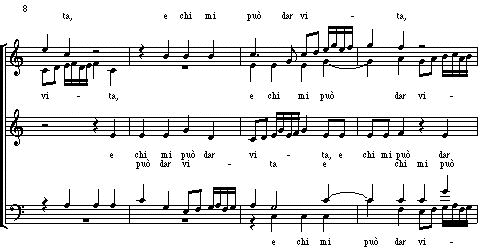
mm. 13-22 "ahi, che m'ancide e non vuol darmi vita"
polyrhythmic changing to monorhythmic, chromatic, medium pace, imitative then chordal.
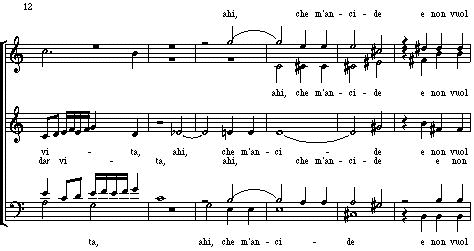

Twentieth Century Polyphony-
Twentieth century composers also use polyphonic process, sometimes
adopting baroque, renaissance, and medieval patterns and procedures.
However, twentieth century polyphony differs from earlier literature
in its use of dissonant intervals and new ways to relate thematic material.
Examples of Two-Part Polyphony in the Twentieth Century-
The next excerpt is a modern setting of an ancient chant. The chant is
stated like a cantus firmus in the bass clef. Note the differences
between the two parts in contour, rhythm, and interval
continuity—and the kinds of harmonic intervals that occur on the
beat, especially in m. 4.
Example 17: Engelkonzert from Mathis der Maler (1934) Paul Hindemith


The next excerpt is repetitive, essential to the effect of this passage.
Although the range of each voice is limited, interest is sustained by
the syncopated interplay between voices. Contours, although limited in
range, move in opposition. The succession of intervals follows no
pattern of tension and release, dissonant intervals are not resolved.
Dissonance is a byproduct of the rhythmic offset between equally
important voices.
Example 18: from Rite of Spring, Second Part, The Exalted Sacrifice (1913) Igor Stravinsky

As suggested by the title of the next excerpt, Bartok made the tritone
an important feature of this composition. The composition is based upon
two tetrachords, a tritone apart. The texture is imitative, but in
inversion. Note the kind of intervals used on accents. The net effect
is dissonant.
Example 19: Diminished Fifth,Vol. IV, Mikrokosmos (1926-1937) Bartok
mm = 110

The final example is the most recently written passage in this series of
excerpts. Its two parts are independent in rhythm, contour, and
content. Dissonant intervals are emphasized. How does the composer's
choice and treatment of intervals prompt you to respond to the passage?
How does this example differ from other examples? All twelve tones of
the chromatic scale are employed in the first three measures.
Example 20: Duet Milton Babbitt

1. Terms
| polyphony | polyphonic texture | canon |
| rhythmic strata | rhythmic layers | double canon |
| imitation interval | time interval | texture variables |
| non-imitative polyphony- | imitative polyphony- | texture constants |
| invention subject |
Application, Analysis
Perform and listen to the composition before attempting an analysis.
Perform and listening periodically during the analysis to check your
findings. When completing the analysis, refer to appendix B (Guide to
Analysis of Contour, Continuity, and Skeleton of Melody), C (Motives and
Their Variants), D (Guide to Analysis of Motives, Phrases, Phrase
Groups), and F (Guide to the Analysis of Musical Texture).
1. Two-Part Invention no. 1, J. S. Bach. The complete
invention is included below. An analysis of the motives was started in
Part 1. One motive was labeled "a/b" because it combines the
rhythm of motive b with the first four notes of motive a. One can also
conclude that all ideas are derived from motive a. Use this analysis as
a guide when completing the analysis of motives used in the remainder of
the work. Write a few paragraphs to explain and compare how the
thematic material was used in Parts 1, 2 and 3 of the invention.









Listen to recording of any or all of these composition, preferably with
score in hand. This as an opportunity to practice score reading.
Follow significant thematic material as it flows from voice to voice.
At the same time, observe changing details in the texture.
Any two-part Invention (Bach),
Any prelude and fugue in the Well Tempered Clavier (J. S. Bach)
Two-part compositions in Mikrokosmos, especially Books 5 and 6 (Bela Bartok)
Any prelude and fugue in Ludis Tonalis (Paul Hindemith),
Hymn and Fuguing Tunes (Henry Cowell)
Rounds for String Orchestra (David Diamond)
Fugal passages from Metamorphisis on a theme by Carl Maria von Weber (Paul Hindemith)
Fugue from Young Person's Guide to the Orchestra (Benjamin Britten)
Dirge of Serenade for Tenor Horn and Strings (Benjamin Britten)
Music for Strings, Percussion, and Celeste, first movement. (Bela Bartok)
Music for Theatre (Aaron Copland)
[Analysis Links]
[Analysis TOC]










































